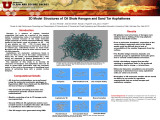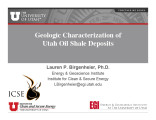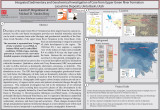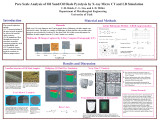TO
Filters: Format: "application/pdf" Research Institute: "Institute for Clean and Secure Energy (ICSE)" Collection: "ir_eua"
| Title | Date | Subject | Description | ||
|---|---|---|---|---|---|
| 1 |
 |
List of SERDP publications and presentations | 2010 | SERDP; SERDP publications; SERDP presentations | Bibliography of SERDP publications |
| 2 |
 |
Publications requirements | 2010 | ||
| 3 |
 |
A unified approach to the various formulations of the one-dimensional-turbulence model | 2010-01 | One-Dimensional Turbulence model; ODT; Stand-alone ODT models; Predicting turbulence statistics; Nonreacting flows; Reacting flows; Governing equations; Turbulent flow field; Linear Eddy Model; Eddy events | The One-Dimensional Turbulence (ODT) model has been successfully applied as a stand-alone model for predicting turbulence statistics in both nonreacting and reacting flows. There are several formulations of the model in the literature, and most of the variable-density formulations do not clearly dis... |
| 4 |
 |
Carbon dioxide sequestration: Effect of the presence of sulfur dioxide on the mineralogical reactions and on the injectivity of CO2+SO2 mixtures | 2010-01 | Carbon dioxide sequestration; CO2; Sequestration stream; Gas injection; CO2+SO2 mixture; Brine; Arkose; Calcite; Anhydrite; Calcium carbonate; CaCO3; Ankerite; Absolute permeabilities; Free-gas; Dissolved gas distribution; Saline formation; Contaminant gases; sulfur dioxide; SO2; Hydrogen sulfide; H... | This report presents experimental and modeling data on certain aspects of carbon dioxide (CO2) sequestration. As different processes are developed and implemented to facilitate the capture of CO2, other contaminant gases (sulfur dioxide, hydrogen sulfide and ammonia) may be present in the sequestrat... |
| 5 |
 |
Clean and secure energy from domestic oil shale and oil sands resources: Quarterly progress report: July 2010 to September 2010 | 2010-10 | ICSE; Oil shale; Oil sands; University of Utah; Marriott Library; Macroscale CO2 analysis; CO2 capture; Flameless oxy-gas process heaters; Liquid fuel production; In-situ thermal processing | The Clean and Secure Energy from Domestic Oil Shale and Oil Sands Resources program is part of the research agenda of the Institute for Clean and Secure Energy (ICSE) at the University of Utah. In this quarter, the Clean and Secure Energy program was involved in multiple technology transfer and outr... |
| 6 |
 |
Clean coal program research activities: Final report: Reporting period 07/01/2006-05/31/2009 | 2010-05 | Environment; Emissions; NOx; SOx; Mercury emission; CO2 emissions; Utah Clean Coal Program; Carbon capture and sequestration; CCS; Green field plants; Simulation; Mergury control; Oxycoal combustion; Gasification; Sequestration; Chemical looping combustion; CLC; Materials investigations; NETL; Coal ... | Although remarkable progress has been made in developing technologies for the clean and efficient utilization of coal, the biggest challenge in the utilization of coal is still the protection of the environment. Specifically, electric utilities face increasingly stringent restriction on the emission... |
| 7 |
 |
Policy analysis of water availability and use issues for domestic oil shale and oil sands development: Topical Report: October 1, 2009 to March 31, 2010 | 2010-03 | oil shale/sands resources; energy source; unconventional fuels; water demands; water availability; domestic oil shale/sands development; topical report | Oil shale and oil sands resources located within the intermountain west represent a vast, and as of yet, commercially untapped source of energy. Development will require water, and demand for scarce water resources stands at the front of a long list of barriers to commercialization. Water requiremen... |
| 8 |
 |
APPENDIX E - Integrated treatment of produced water by chemical and biological unit operations, A subpart of project - Quantifying water availability impacts and protecting water quality while developing Utah oil shale and sands - Final Project Report - Reporting period: June 21st, 2006 to October 21st, 2009 | 2010-10-07 | Water treatment; Water quality - Utah; Oil shale and sands | Water generated along with oil, gas, and coal bed methane production is commonly known as produced water, formation water, or oilfield brine [1]. Produced water represents the largest waste stream volume in production operations on most offshore platforms [2]. According to the American Petroleum Ins... |
| 9 |
 |
Atomistic modeling of oil shale kerogen and asphaltenes | 2010-04-28 | Kerogen is a mixture of organic chemical compounds that make up a portion of the organic matter in sedimentary rocks. It is insoluble in normal organic solvents because of the large molecular weight (upwards of several thousand Daltons). When heated in the Earth's crust (oil window ca. 60 ° - 120 �... | |
| 10 |
 |
Clean and secure energy from domestic oil shale and oil sands resources: Quarterly progress report: April 2010 to June 2010 | 2010-07-31 | ICSE; Oil shale; Oil sands; Oxy-fuel; CO2 capture; OXYFLAM; Uinta Basin; Utah; Parachute Creek Member; X-ray microtomography; Freen River oil; Kerogen; Thermal gravimetric analyzer experiments | The Clean and Secure Energy from Domestic Oil Shale and Oil Sands Resources program is part of the research agenda of the Institute for Clean and Secure Energy (ICSE) at the University of Utah. In this quarter, the Clean and Secure Energy program continued its efforts to enhance the dialogue between... |
| 11 |
 |
Clean and secure energy from domestic oil shale and oil sands resources: Quarterly progress report: January 1, 2010 to March 31, 2010 | 2010-05-13 | ICSE; University of Utah; CO2 capture; Mahogany zone; Green River Formation; Utah; Uinta Basin; Oil sands; Crude oil refining; International Flame Research Foundation; Liquid fuel production; In-situ thermal treatment; Oil shale; Pyrolysis | The Clean and Secure Energy from Domestic Oil Shale and Oil Sands Resources program is part of the research agenda of the Institute for Clean and Secure Energy (ICSE) at the University of Utah. In this quarter, the Clean and Secure Energy program continued its focus on enhancing industrial, national... |
| 12 |
 |
Clean and secure energy from domestic oil shale and oil sands resources: Quarterly progress report: October 2009 to December 2009 | 2010-02-03 | ICSE; Clean and Secure Energy program; CASE; Itasca Group; Red Leaf Resources; Enshale's; Vernal, Utah; oxy-fuel; CO2 capture; Oil shale; Oil sands; Crude oil; CO2 emissions; International Flame Research Foundation; Pyrolysis; Lattice Boltzmann; Kerogen; Oil recovery simulation; TGA; Dry shale; Pyro... | The Clean and Secure Energy from Domestic Oil Shale and Oil Sands Resources program is part of the research agenda of the Institute for Clean and Secure Energy (ICSE) at the University of Utah. The program was officially launched on October 1, 2009. The project management plan was submitted for revi... |
| 13 |
 |
Clean and secure energy from Utah's oil shale and oil sands resources: Environmental, legal and policy framework | 2010-04-28 | ICSE; Land use; Water availability; Produced water; Utah; Colorado; Colorado River | This poster addresses major challenges to land use, water availability, and produced water. |
| 14 |
 |
Effect of pressure on copper/copper-oxide system functioning as an oxygen carrier in chemical looping combustion | 2010-06-10 | copper/copper-oxide system; chemical looping combustion; CLC; high pressure thermogravimetic analysis | Chemical Looping Combustion (CLC) is a promising technology that will utilize more efficient harvesting of energy along with decreased CO2 emissions into the atmosphere. In CLC system the emissions are composed of CO2 and H2O allowing the CO2 to be captured and disposed of in an environmentally more... |
| 15 |
 |
Enhanced in-situ production through fracturing | 2010-04-28 | in-situ production; fracturing; fracturing methods | Rationale For Fracturing: 1) Ultra-Low Matrix Permeability 2) Poorly Interconnected Fracture Network 3) Desire to Maximize Surface Area, Minimize Transport Distance In Matrix and Increase Conductivity of Flow Paths For Production 4) Increase Surface Area, Increase Fracture Frequency |
| 16 |
 |
Federal control of greenhouse gas emissions | 2010-04-28 | greenhouse gas emissions; federal control efforts; domestic legislation | Federal Control Efforts: 1) International 2) New Domestic Legislation 3) Using Existing Domestic Legislation |
| 17 |
 |
Geologic characterization of Utah oil shale deposits | 2010-04-28 | oil shale development; geologic framework; lake evolution; oil shale; stratigraphic correlation | Why Geology? Economic prospectivity of oil shale development in the Uinta Basin relies heavily on establishing a solid geologic framework. Understanding lake evolution matters. |
| 18 |
 |
Ignition in 40kw co-axial turbulent diffusion oxy-coal jet flames | 2010-08-08 | 40kw co-axial turbulent diffusion; diffusion; oxy-coal; oxy-coal jet flames; partial pressure of O2; coal transport | Outline: 1) Introduction 2) Objectives 3) Experimental setup 4) Methodology to quantify flame stability 5) Results and discussion 6) Conclusions 7) Acknowledgements. The objective of this presentation is to better understand, the effects of partial pressure of O2 in a) the coal transport jet, and b)... |
| 19 |
 |
Integrated sedimentary and geochemical investigation of core form the upper Green River Formation lacustrine deposits, Uinta Basin, Utah | 2010-04-12 | upper Green River formation; lacustrine deposits; geochemical investigation; lithofacies; facies | Description of the upper Green River Formation has been largely based on outcrop exposures, but this core-based investigation provides newly detailed subsurface data that can be used to examine basin-wide lithologic and geochemical variability of he Parachute Creek Member of the upper Green River Fo... |
| 20 |
 |
Oxy-gas process heaters for efficient CO2 capture | 2010-04-28 | oil shale and oil sands technology; greenhouse gas emissions; GHG; large eddy simulation; LES; IFRF OXYFLAM | Implementation of oil shale/sands technologies in U.S. will require mitigation of greenhouse gas (GHG) emissions. |
| 21 |
 |
Phase 2: Clean and secure energy from coal: Quarterly progress report: April 1, 2010 to June 30, 2010 | 2010-08-01 | domestic coal resources; CO2 capture; stationary power generation; DQMOM approach | The University of Utah is pursuing research to utilize the vast energy stored in our domestic coal resources and to do so in a manner that will capture CO2 from combustion from stationary power generation. The research is organized around the theme of validation and uncertainty quantification throug... |
| 22 |
 |
Phase 2: Clean and secure energy from coal: Quarterly progress report: July 1, 2010 to September 30, 2010 | 2010-10-01 | domestic coal resources; CO2 capture; stationary power generation; Oxycoal; OFC; coal | The University of Utah is pursuing research to utilize the vast energy stored in our domestic coal resources and to do so in a manner that will capture CO2 from combustion from stationary power generation. The research is organized around the theme of validation and uncertainty quantification throug... |
| 23 |
 |
Phase 2: Clean and secure energy from coal: Quarterly progress report: October 1, 2009 to December 31, 2009 | 2010-01-30 | domestic coal resources; CO2 capture; stationary power generation; oxy-coal flames; coal gasification process | The University of Utah is pursuing research to utilize the vast energy stored in our domestic coal resources and to do so in a manner that will capture CO2 from combustion from stationary power generation. The research is organized around the theme of validation and uncertainty quantification throug... |
| 24 |
 |
Pore scale analysis of oil sand/oil shale pyrolysis by X-ray Micro CT and LB simulation | 2010-04-28 | unconventional fuels; characterization of the pore networks; oil sand/shale resources; LB simulation; pyrolysis reations; Multiscale X-ray Micro/Nano Tomography | The research objectives include (1) CT characterization of the pore network structure for selected oil sand/oil shale resources, (2) LB simulation of flow through pore network structures to predict transport properties, such as permeability, and (3) CT analysis of pore network structure during pyrol... |
| 25 |
 |
Pore scale analysis of oil sand/oil shale pyrolysis by X-ray Micro CT and LB simulation | 2010-03-03 | pore scale analysis; oil sand/shale pyrolysis; X-ray Micro CT and LB simulation; Lamellar Structure of Oil Shale | The research objectives include (1) CT characterization of the pore network structure for selected oil sand/oil shale resources, (2) LB simulation of flow through pore network structures to predict transport properties, such as permeability, and (3) CT analysis of pore network structure during pyrol... |
